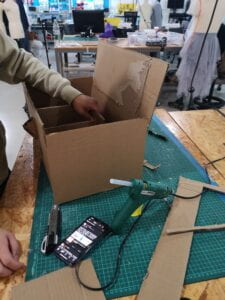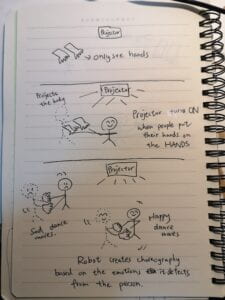1.
Dance is one form of art, but usually requires skills and talent. We hope people can express their emotions through art or just simply perform art without limitations. The invention of our group is the device that creats a choreography based on the emotion of the person who touches it, and can lead the person dancing.
To come up with the idea, we first met as a group and then introduced our own inventions we created at the RESEARCH phase. And all of us found the one from Robbin was very interesting, which was some robots dancing along with the Naxi music band the main character watched with the woman in The Fish of Lijiang. We made an advanced version of his proposal:
The invention is mainly a pair of artificial hands. When a person places his/her hands on that pair of hands, the projector automatically turns on and the image of its body appears. Meanwhile, it detects the physiological and mental conditions of the person that recognize his/her emotion. It then creates a choreography with moves reflecting the emotion. Holding the hands, people can dance along with the robot without learning it in advance or memorizing the choreography.
In our performance, we included a cardboard projector and a cardboard helmet for the robot. When the projector is turned on, the robot took off the helmet representing her appearance.

We also used masks with mouth drawn on it to represent the emotion of the users. The first user was sad and they danced in a sad mood 🙁 while the other was happy because her friend gave her a gift and they danced happily together 🙂 . And because we perform without talking, we had a little cardboard instrument that played the beats for the dance.
We evenly distrubuted our work. Since most of the scenes were between two actors, we discussed the story and the dance in small groups two by two seprately. As a first sad character myself, I discussed with Vivian about the trigger that made me sad; and with Tracy, the robot, we created the choreography that showed the sadness. Our group members had participated in the cardboard workshop where they made some of the items, and the rest we did as a whole group. We also rehearsed for several times.
Our performance in class:
One thing I like about our invention is that it is very interesting–imagine yourself being able to dance in a way you never think you are capable of. And it allows people to express their feeling, which is one thing that is vital for people dealing with stress and depression.
It’s interactive because it aligns to how we define interaction. It is a conversation between two subjects and it reacts to each other. The robot doesn’t activate itself until the user touches it and the user can also receive input, which is the guidance of dance.
However, there are also limitations in our invention. When we came up with the idea, we didn’t specify how the emotions are detected, meaning, what kind of things are sensed and are taken in to account. Neither did we specify how people are controlled by the robot with just the connection between hands.
2.
The group which presented a subjective clock and a objective clock was really impressive. Their story setting was a student taking GPS in school. There was a helmet on the student’s head that can detect his braiwave. And there were two clock, one objective which was the time running in the real world and one subjective–what the student experience personally. When the student feel bored his subjective time slows down. This was in relation to the concept of The Fish of Lijiang where the time can be distorted and felt differently person from person. But from my perspective, instead of relating to the fictional concept The Fish of Lijiang presents, they were talking about the experience we are going through everyday, since sometimes we feel like time are passing slow when we feel bored and fast when we wish time stops at the moment forever.
The performance was very interesting. They assigned the two clocks with characteristics that made them communicate with each other to better convey their ideas to the audience. It reminds me of the cartoon movie Inside Out, in which the emotions and every mental activities are living under a real life setting with a system to run the community.
But I doubt they met the criteria of making it interactive. There was only a one-direction process, which was the device detecting the student’s brain. The brain outputs information, the device processes and the clocks input. But the student didn’t receive any feedback to further react to the other subject. One thing they can think about is that after the two clocks appear, the student also receives the information, and is able to manage or play with it.

Leave a Reply